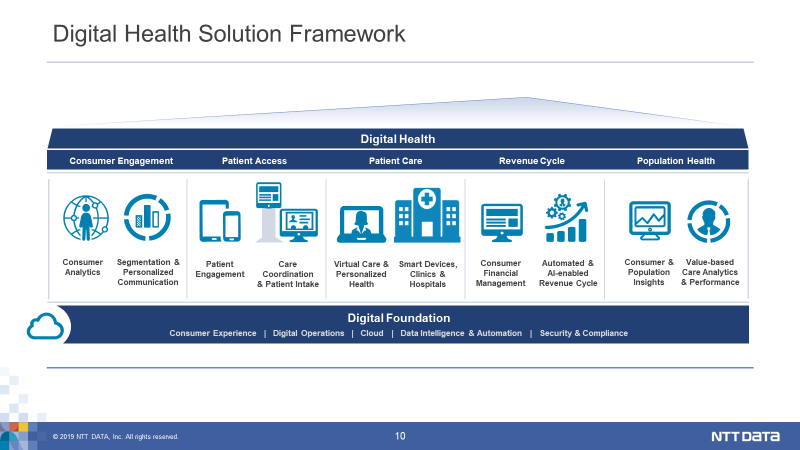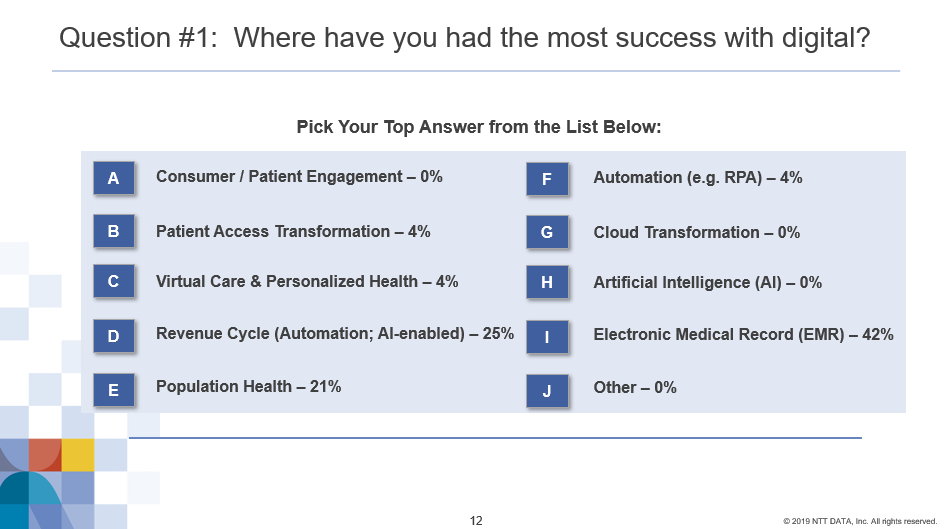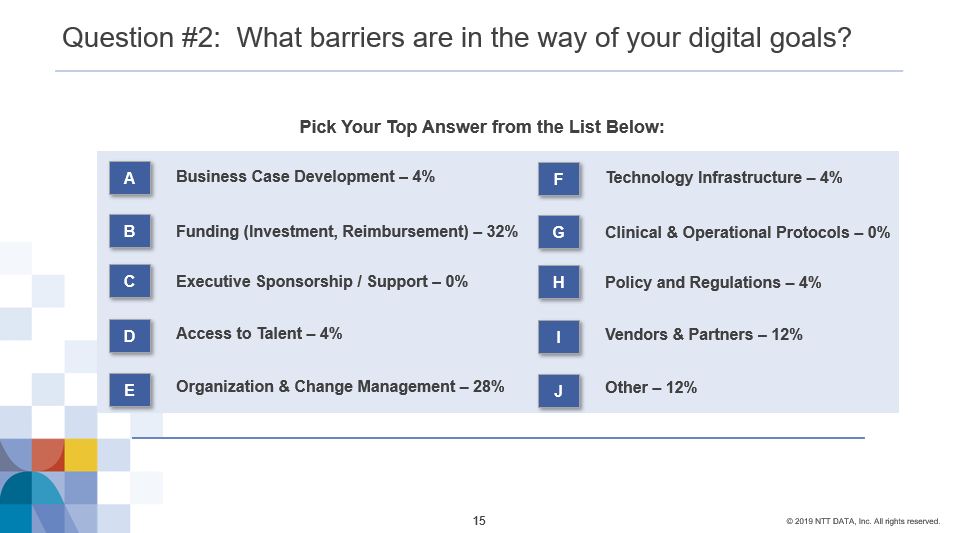The healthcare sector faces economic pressures as consumers assume greater financial responsibility for their care and government payers roll out aggressive, value-based reimbursement models. These factors are pushing providers to deliver more integrated, team-based, coordinated care. To achieve these goals, healthcare systems must transform their IT, processes and organizational infrastructures, as well as their organizational cultures.
At Becker's 5th Annual Health IT + Revenue Cycle Conference in Chicago, NTT DATA sponsored an executive roundtable to discuss how digital health tools can address these pressing issues. Attendees included health IT leaders and provider organization executives. Mary Edwards, president of NTT DATA's provider division, facilitated an interactive discussion with session participants.
Digital health — Hard to define and challenging to implement
In healthcare, digital means different things to different people. When asked to define digital in a few words, attendees suggested automated, accessible, convenient, consumer-focused and paperless, among others. NTT DATA defines digital as "leveraging technology to create new forms of value."
Healthcare systems are increasingly using digital initiatives to improve financial performance, reduce the cost of care and enhance quality and consumer access. Ms. Edwards noted, "Digital can reinvent the experience for clinicians and care teams. Digital can help patients navigate care and can also connect the care-teams, care-givers, and social systems that support patients in their care-journey."
Like many technical innovations of the past, digital initiatives often fail to yield results. It can be difficult to quantify the benefits of digital investments and it can be challenging to assess results. Digital investments require new and diverse capabilities – new technical and data integration skills, new change management approaches, and new digital engagement processes. Often, digital investments integrate heretofore unintegrated adjacent business processes - driving value to a broad set of constituents (IT teams, administrative teams, care-teams, caregivers and patients) and making the full value difficult to track and measure. In addition, siloed efforts within the same organization often increase cost and compete for consumer-attention and adoption. The key to successful digital health transformation, NTT DATA believes, is in driving from a digital health framework that integrates the various digital efforts into a roadmap that accounts for and enables transformation readiness planning for all of the internal and external stakeholder impacts. This same framework and roadmap becomes the basis for business case development and results monitoring.
NTT DATA has developed a digital health framework that includes a digital foundation and enablement capabilities, and integration points across capabilities, to assist healthcare systems in their digital transformation journeys. That framework includes:
- Digital Health Enablement:
- Consumer Engagement
- Patient Access
- Patient Care
- Revenue Cycle
- Population Health
- Digital Foundation:
- Consumer Experience
- Digital Operations
- Cloud
- Data Intelligence & Automation
- Security & Compliance
The framework is premised on the integration of adjacent processes and capabilities into a seamless value chain, that internal and external constituents experience. Ms. Edwards said, "It’s the integration across these adjacencies that drive the highest value to constituents and the value to organizations."

Where healthcare organizations succeed with digital
To gauge where healthcare organizations have had success with digital technologies, roundtable attendees participated in a poll. Given the emphasis in recent years on EMR implementation, it was not surprising that 42 percent of attendees cited this as the digital initiative where they have been most successful. Other areas of note included revenue cycle management (25 percent) and population health (21 percent).

As session participants engaged in roundtable discussions about their digital initiatives, several themes emerged.
- Provider organizations are beginning to pivot from EMR’s to investments to digital investments that leverage the EMR to drive value through the integration of the EMR into consumer-facing processes (patient access, virtual care)
- Provider organizations are challenged with cloud transformation and the application of AI and Automation in their digital agendas
- Provider organizations continue to lag other industries in consumer / patient engagement
Funding and change management: Major barriers to achieving digital goals

When asked to identify obstacles to attaining digital goals, about one third of the participants (32 percent) see funding as the primary barrier and 28 percent suggested that change management was a major.
Organizational change requires considerable effort. Many healthcare systems don't recognize up front that they must devote resources to it. Change management done right drives alignment, adoption, and value to organizations. One attendee noted, "The C-suite isn't aligned on objectives, goals and vision. Technology is just thrown at people and it makes them very unhappy." Organizations that develop a vision and align the organization around the outcomes desired from digital investments have greater success in achieving and measuring outcomes from digital investments.
Other barriers to success with digital initiatives discussed included interoperability of IT systems, access to talent, and data quality. According to one session participant, "You don't just need IT data geeks, you need people in the business who understand the data, so they can draw conclusions and give you outcomes."
Future of digital investments in healthcare
Among the participants, empowering patients and transforming the patient experience was top of mind for many. Participants cited digital initiatives such as patient portals, access centers, systems that track customer engagement, telehealth and population health services among their upcoming investments. One of the participants cited the use of AI solutions to automate claims management in order to free staff to deliver higher levels of service, for instance engaging with patients to explain bills and what services insurance covers.
Although healthcare organizations have been reluctant to put patient data in the cloud for security reasons, there was a great deal of discussion on how cloud migration can drive cost reductions and enable investment in digital portfolios.
Finally, quality measures and the CMS Interoperability and Patient Access proposed rule are causing healthcare systems to rethink data and who controls it.
Realizing the value of digital health: Recommendations and best practices
Based on NTT DATA's experience with numerous healthcare providers, Ms. Edwards shared some tips for realizing the value of digital health:
- Develop a clear vision, strategy, and roadmap for change. Translating the organization’s vision and strategy into a framework that can be used to communicate and drive alignment will help connect what otherwise may seem disparate initiatives.
- Understand patient and provider experiences. What would make a difference to these constituent groups in the way they experience digital healthcare enablement? Focus on those experiences that drive the most abrasion as these are the sources of waste as well as stakeholder dissatisfiers.
- Make it an enterprise wide priority with leadership support. Digital projects often span multiple silos. Ms. Edwards noted, "Digital healthcare enablement spans business processes and organizations. A common digital strategy and governance of that strategy across all leaders can lead to greater success."
- Establish clear accountabilities and a strong team to drive the efforts. Structuring for success requires clear accountabilities and teams that are empowered, enabled, and possessing the requisite skills to deliver digital agendas.
- Establish a strong business case and measure outcomes. A good business case focuses on quantitative and qualitative measures. Monitoring achievement of both can help fine tune the strategy over time.
- Implement governance with technology as well as clinical and business teams. Often organizations focus on strong governance of projects and ignore the governance needed to drive transformation readiness and adoption.
- Pick great partners who collaborate with others. Digital is driving new types of collaboration and partnership in a rapidly changing healthcare landscape. Look for partners who can provide integrative frameworks responsive to the fluidity of digital and who demonstrate an ability to collaborate in multi-partner scenarios.
- Align innovations and efforts with priority use cases. This includes patient and provider expectations, as well as enterprise wide priorities. As Ms. Edwards explained, "Do the smart things right and first."
- Apply digital in the context of the holistic care delivery and wellness model. Understanding and mining the integration points across adjacent care delivery and administrative processes as well as potential stakeholder value integration points that exist external to the organization can provide the highest return on investment and return on stakeholder experience.
Conclusion
In recent years, EMR integration has been the primary focus of digital investment for most healthcare systems. As organizations turn their attention to new digital initiatives in areas such as patient engagement, revenue cycle management and telehealth, they would be wise to reflect on lessons learned from the past.
Ms. Edwards observed, "We hear a variety of healthcare systems say that they have had challenges realizing the promise of EMR implementations. As organizations now embark on the next wave of digital investments, it will be important to define the digital journey for constituents, inclusive of the EMR integrations points, doing so through a digital health framework can assist organizations with strategy alignment, business case achievement, and transformation readiness focused on preparing all constituents for change."